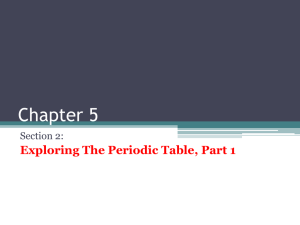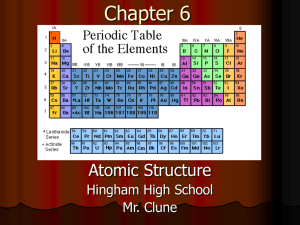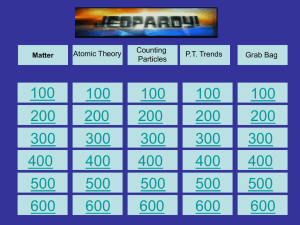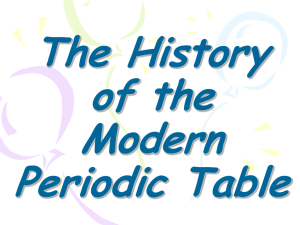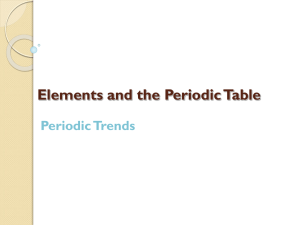Periodic Trends - slider-dpchemistry-11
advertisement
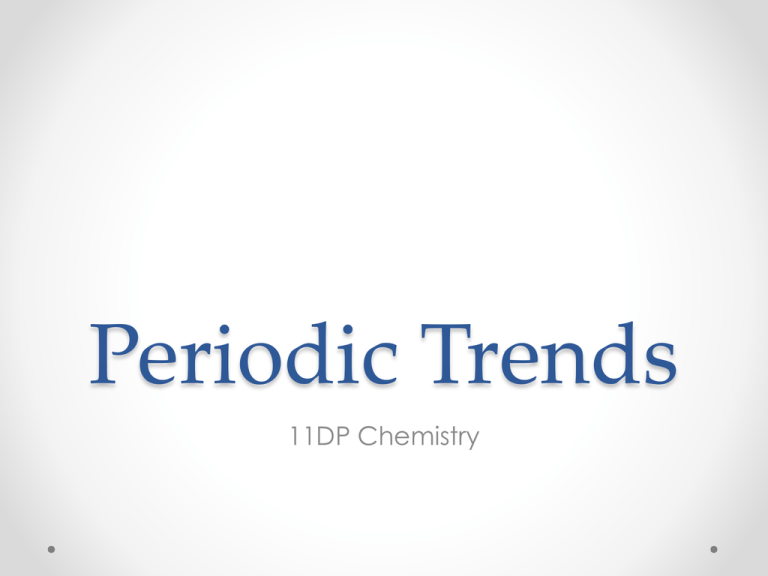
Periodic Trends 11DP Chemistry Periodic Properties Certain physical and chemical properties recur at regular intervals, and/or vary in regular fashion, when the elements are arranged according to increasing atomic number. Melting point, boiling point, hardness, density, physical state, and chemical reactivity are periodic properties. We will examine several periodic properties that are readily explained using electron configurations. Periodic Properties: Atomic Radius The distance from the center of the nucleus to the outer boundary of the e-cloud is the atomic radius. Covalent radius: half the distance between the nuclei of two identical atoms joined in a molecule. Metallic radius: half the distance between the nuclei of adjacent atoms in a solid metal. Periodic Properties: Atomic Radius • Atomic radius increases from top to bottom within a group. • The value of n increases, moving down the periodic table. • The value of n relates to the distance of an electron from the nucleus. Periodic Properties: Atomic Radius • Atomic radius decreases from left to right within a period. • Why? The effective nuclear charge increases from left to right, increasing the attraction of the nucleus for the valence electrons, and making the atom smaller. Mg has a greater effective nuclear charge than Na, and is smaller than Na. Atomic Radii of the Elements Exercise 1 With reference only to a periodic table, arrange each set of elements in order of increasing atomic radius: (a) Mg, S, Si (b) As, N, P (c) As, Sb, Se Ionic Radii The ionic radius of each ion is the portion of the distance between the nuclei occupied by that ion. Ionic Radii • Cations are smaller than the atoms from which they are formed; the value of n usually decreases. Also, there is less electron–electron repulsion. Ionic Radii • Anions are larger than the atoms from which they are formed. • Effective nuclear charge is unchanged, but additional electron(s) increase electron–electron repulsion. • Isoelectronic species have the same electron configuration; size decreases with effective nuclear charge. Some Atomic and Ionic Radii Exercise 2 Refer to a periodic table and arrange the following species in the expected order of increasing radius: Ca2+, Fe3+, K+, S2–, Se2– Ionization Energy • Ionization energy (I) is the energy required to remove an electron from a ground-state gaseous atom. • I is usually expressed in kJ per mole of atoms. M(g) M+(g) + e– ΔH = I1 M+(g) M2+(g) + e– ΔH = I2 M2+(g) M3+(g) + e– ΔH = I3 Ionization Energy Trends • I1 < I2 < I3 o Removing an electron from a positive ion is more difficult than removing it from a neutral atom. • A large jump in I occurs after valence electrons are completely removed (why?). • I1 decreases from top to bottom on the periodic table. o n increases; valence electron is farther from nucleus. • I1 generally increases from left to right, with exceptions. o Greater effective nuclear charge from left to right holds electrons more tightly. Selected Ionization Energies Compare I2 to I1 for a 2A element, then for the corresponding 1A element. Why is I2 for each 1A element so much greater than I1? Why don’t we see the same trend for each 2A element? I2 > I1 … but only about twice as great … Selected Ionization Energies General trend in I1: An increase from left to right, but … …I1 drops, moving from 2A to 3A. The electron being removed is now a p electron (higher energy, easier to remove than an s). I1 drops again between 5A and 6A. Repulsion of the paired electron in 6A makes that electron easier to remove. First Ionization Energies Change in trend occurs at 2A-3A and at 5A-6A for each period … … but the change becomes smaller at higher energy levels. Exercise 3 Arrange each set of elements in the expected order of increasing first ionization energy. (a) Mg, S, Si (b) As, N, P (c) As, Ge, P Electron Affinity Electron affinity (EA) is the energy change that occurs when an electron is added to a gaseous atom: M(g) + e– M–(g) ΔH = EA1 • A negative electron affinity means that the process is exothermic (i.e. energy released). • The electron affinity is a measure of the attraction between the incoming electron and the nucleus - the stronger the attraction, the more energy is released. • Nonmetals generally have more affinity for electrons than metals do. (Nonmetals like to form anions!) • Electron affinity generally is more negative or less positive on the right and toward the top of the periodic table. Selected Electron Affinities The halogens have a greater affinity for electrons than do the alkali metals, as expected. Electronegativity • • • Electronegativity is the ability of an atom to attract an electron pair The most commonly used scale of electronegativity is that developed by Linus Pauling in which the value 4.0 is assigned to fluorine, the most electronegative element. Lithium, at the other end of the same period on the periodic table, is assigned a value of 1. Electronegativity generally increases from left to right on the periodic table and decreases from top to bottom. Metals are the least electronegative of the elements. Electronegativity Exercise 4 A Conceptual Example Which of the values given is a reasonable estimate of the second electron affinity (EA2) for sulfur? S–(g) + e– S2–(g) –200 kJ/mol +800 kJ/mol +450 kJ/mol +1200 kJ/mol EA2 = ? Metals • Metals have a small number of electrons in their valence shells and tend to form positive ions. o For example, an aluminum atom loses its three valence electrons in forming Al3+. • All s-block elements (except H and He), all d- and fblock elements, and some p-block elements are metals. Metallic Character • Metallic character is related to atomic radius and ionization energy. • All metals tend to lose electrons • Metallic character generally increases from right to left across a period, and increases from top to bottom in a group. Nonmetals • Atoms of a nonmetal generally have larger numbers of electrons in their valence shell than do metals. • Many nonmetals tend to form negative ions. • All nonmetals (except H and He) are p-block elements. Nonmetallic character generally increases rightto-left and increases bottom-to-top on the periodic table (the opposite of metallic character). Metalloids • A heavy stepped diagonal line separates metals from nonmetals; some elements along this line are called metalloids. • Metalloids have properties of both metals and nonmetals. A Summary of Trends Exercise 5 In each set, indicate which is the more metallic element. (a) Ba, Ca (b) Sb, Sn (c) Ge, S Exercise 6 A Conceptual Example Using only a blank periodic table, state the atomic number of (a) the element that has the electron configuration 4s2 4p6 4d5 5s1 for its fourth and fifth principal shells and (b) the most metallic of the fifth-period p-block elements. The Noble Gases • The noble gases are on the far right of the periodic table between the highly active nonmetals of Group 7A and the very reactive alkali metals. • The noble gases rarely enter into chemical reactions because of their stable electron configurations. • However, a few compounds of noble gases (except for He and Ne) have been made. Recall: Atoms emit energy when electrons drop from higher to lower energy states Flame Colors Elements with low first ionization energies can be excited in a Bunsen burner flame, and often emit in the visible region of the spectrum. Li Na Elements with high values of IE1 usually require higher temperatures for emission, and the emitted light is in the UV region of the spectrum. Ca Sr K Ba
